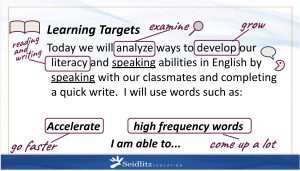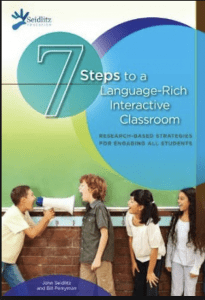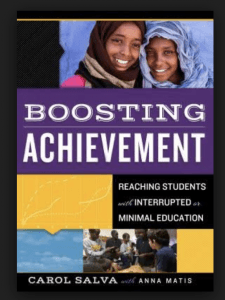Top Tips for receiving a Newcomer mid year!
 I received a great question from Derek Rhodenizer this week. I suggest everyone follow Derek, by the way. He is a great source of inspiration and innovation!
I received a great question from Derek Rhodenizer this week. I suggest everyone follow Derek, by the way. He is a great source of inspiration and innovation!  And we were fortunate to have Stephen Hurley chime in as well! He is the Chief Catalyst at VoicEd Radio and another one to follow!
And we were fortunate to have Stephen Hurley chime in as well! He is the Chief Catalyst at VoicEd Radio and another one to follow!
Listen to the show in your favorite podcast app or right here:
Listen to “BAP064 One Newcomer Mid Year! What Now?” on Spreaker.
Derek is the head of a school in Ottawa & one of his 4th grade teachers received a brand new newcomer 1/2 way through the year. The target language is actually French, but that doesn’t really matter for what I am going to recommend.
This 4th grade teacher is asking for strategies that will help this new child who is the only child in class who is not comprehending the language of instruction. She is brand-new to this language. Understandably, the teacher is translating a lot and this will slow down instruction.
Here are some notes and links to what I talked about on this show.
MINDSET: Please don’t panic or over stress. Please realize that everyone will acquire more understanding of your language each day.  Every day it gets easier for that child. We can even do things to make this ability to understand go faster. So we need to relax a bit as teachers and not fear that this will be the same issue… to this degree… all year long. We need to remind ourselves EVERY day that our newcomer student will be understanding a bit more each day as time goes on. (It may not look like it because speaking usually takes longer than understanding). Staying in this mindset is easier said than done, so I suggest that you plan with someone who can remind you of this. We are on Twitter and happy to be the ones to answer questions or collaborate with you. Here is a video that can help remind us of how newcomers acquire not only speaking ability but also reading. Reading in your new language comes faster with repetition and high-interest text. Emmanuel could not read in ANY language but with repetition, and high interest, he could not only read, he gained a great deal of language:
Every day it gets easier for that child. We can even do things to make this ability to understand go faster. So we need to relax a bit as teachers and not fear that this will be the same issue… to this degree… all year long. We need to remind ourselves EVERY day that our newcomer student will be understanding a bit more each day as time goes on. (It may not look like it because speaking usually takes longer than understanding). Staying in this mindset is easier said than done, so I suggest that you plan with someone who can remind you of this. We are on Twitter and happy to be the ones to answer questions or collaborate with you. Here is a video that can help remind us of how newcomers acquire not only speaking ability but also reading. Reading in your new language comes faster with repetition and high-interest text. Emmanuel could not read in ANY language but with repetition, and high interest, he could not only read, he gained a great deal of language:
Stephen Krashen’s work tells us that language happens effectively through meaningful interaction. Krashen is a 2nd Language Acquisition guru and the prior video is a great example of what he claims. His other well regarded theory is that of the Affective Filter. He suggests we do what we can to help lower stress for students because a filter (an Affective Filter) goes up when you are stressed or feeling negatively about yourself.
And here are the only 2 things your newcomer needs to get a new language:
- Comprehensible Input
- Low Stress Opportunities for Output
- So as the teacher, stay in the language of instruction and use more visuals and gestures. Look for ways to make your content more understandable without translating. Gestures and visuals are the top tips from me on that (many of my fast-moving students tell us this). So you can give your regular mini lesson to the class but use more gestures, pointing, and images as much as possible. Slow down just slightly (so she can hear the breaks in the words) but not noticeably. Just a few key sentences that you might want everyone hearing well. (when you learn new language and people speak quickly, you cant tell where one word stops and the next one starts). These actions provide for more comprehensible input…which is what newcomers need. They just need the GIST of what you are talking about so they don’t get overwhelmed in your mini lesson. Don’t stop and translate for her. Make sure she knows to watch you and try to make sense of as much as possible and that she will always get a chance to get more meaning after you are done by talking to peers and working in collaborative groups. Do not translate, just start pantomiming EVERYTHING you say. Tell the class that they should all do this because people can understand A LOT when we use gestures. Watch this video to see what I mean. You would not go this slowly. Valentina is just illustrating that even if you do not have ANY language comprehension, she can help you understand with visuals and gestures. You can even show this video to your class so they help in this way.
- Train your new student to understand that they will get more of the new language every day. They need to be as comfortable as possible. So let them know that they don’t need to understand 100%. They just need the GIST and they will have lots of opportunities to talk to other students and ask questions. But they should repeat and copy and follow print every day. Make sure they know this is KEY to acquiring more language. Some words are high-frequency, so they will start to get them with repetition. Some words are familiar or similar to words in their language and other words will have visuals or gestures with them so each day this will become easier. YES! You can always get a key word or phrase in your first language from your peers or a translator, and you can speak in your first language, but we will be explaining most things to you in French with visuals and gestures as much as possible. This is a longer video and is for newcomer teachers to train their entire class. But you might find it useful if anyone is going to explain to the newcomer the basics of how things should come together. I also have a ppt and post about it here.
- Teach to the top and then facilitate group work as much as possible. Your mini lesson is to the high flyers, your top 25%. They will get the concept and be in a position to lead a group on collaborative work. Your high flyers should be all around the room so that you are not having to repeat your instructions. Allow kids to work together. “Whatever the top 25% of your class can do, everyone can do collaboratively.” – Leo Gomez. The following graphic is from the Gomez & Gomez Dual Language Enrichment program and has served me in ANY class where I have taught anything. How kids are seated allows me to teach to the top. So your newcomer is not part of the top 25% of the class. That is okay. 75% of your students may not be absolutely clear on the learning from your mini lesson. That is intentional. They will get it working together. In the last few minutes of class, you may need to pull a handful of kids who did not get it in the mini lesson or the guided activity. But they heard it twice and may just need some concept refinement. And that should be a smaller group. Try not to sit your lowest kids right next to your highest kids. This can cause frustration. As much as possible have them like this. But in my reality, I just need to mix kids up over and over as often as possible. That said, this arrangement is the goal:
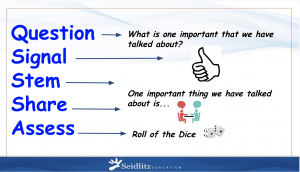 TOP TIP!! Allow kids to talk to process or negotiate meaning every 8-10 minutes. Plan at least ONE structured conversation so that everyone is set up for success. This is key for all high-functioning classrooms. The person doing the speaking is the person doing the thinking. Do not dumb-down language. It does not hurt your newcomer to hear academic complete sentences.
TOP TIP!! Allow kids to talk to process or negotiate meaning every 8-10 minutes. Plan at least ONE structured conversation so that everyone is set up for success. This is key for all high-functioning classrooms. The person doing the speaking is the person doing the thinking. Do not dumb-down language. It does not hurt your newcomer to hear academic complete sentences. 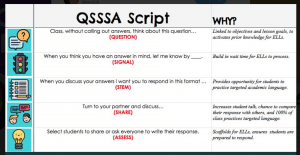 She just needs a conversation where she can get the meaning. But your entire class benefits from a structured conversation. Some of this will be important for your newcomer but really, all kids will benefit. To structure conversations, we recommend using the QSSSA strategy. This is recommended as a top tip for all classrooms. Structured conversations lead to a 19 point percentile gain in achievement for all kids in multiple studies (Marzano 2001) Find a TON of #QSSSA on the internet by Googling it and also looking at Images. Here is a great blog post about what it is and how to do it.
She just needs a conversation where she can get the meaning. But your entire class benefits from a structured conversation. Some of this will be important for your newcomer but really, all kids will benefit. To structure conversations, we recommend using the QSSSA strategy. This is recommended as a top tip for all classrooms. Structured conversations lead to a 19 point percentile gain in achievement for all kids in multiple studies (Marzano 2001) Find a TON of #QSSSA on the internet by Googling it and also looking at Images. Here is a great blog post about what it is and how to do it. - Create and train the entire class to use an “Instead of I Don’t Know” poster. This lets you randomly call on students but also supports a lower stress environment. Your newcomer can memorize “May I ask a friend for help?” so that she can start to be empowered and not worried she may be called on. She may start to take risks sooner because she knows she can fall back on that phrase. We are empowering every student with this but it is critical for your newcomer to have a few of these phrases. Make a poster like this one and ask kids why it is important for all of us to use these instead of saying IDK.
Teach Ss what to say instead of “I Don’t Know”. Opting out is not an option….empower students while holding them accountable.
Banish “I Don’t Know” by scaffolding with these sticky notes. #BoostingAchievement #BCTESOL #Ellchat_BkClub @MsSalvac
Link: https://t.co/k8bMmearJN pic.twitter.com/Lb31PulLlY
— Michelle Gill (@MrsGill_) October 26, 2019
- If anyone has time to work with her one-on-one, you can really help her accelerate her reading in French. I suggest that you co-create text WITH her. Ideas that are FROM her. Here is an example of how students who were illiterate and beginners in English (and from poverty) gained a great deal of reading ability in their first year. So if this child can read in her native language, she has more advantages than many of these students:
- Frame your lesson. Go over the objectives on the board so every child gets a chance to practice academic language and every child is clear about the expected goals. Your newcomer gets to practice output (pronouncing words in the target language) in a low stress way. But your fluent students ALSO need to practice complete, academic sentences. You can also use this as a vocabulary strategy so put higher language in your objectives as time goes on. This goes to John Hattie’s work on teacher clarity. This has a huge effect on achievement of the average child (being clear on what the goals will be). Be sure to ALWAYS track the print with your fingers when you read anything and let her know to watch you do that so she starts to grab more of the high frequency words and sounds of the letters.
- Implement the 7 Steps to a Language Rich, Interactive Classroom. (FYI: If you use QSSSA, and put up an IDK poster, you’re doing 5 of the steps!) Here they are along with a padlet that has more resources for the steps including downloads
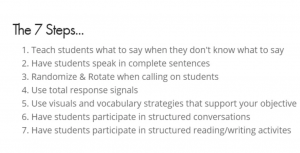
A great deal of this comes from these two books.
7 Steps to a Language-Rich, Interactive Classroom
Boosting Achievement, Reaching Students with Interrupted or Minimal Education
I hope it is helpful!!
Carol




